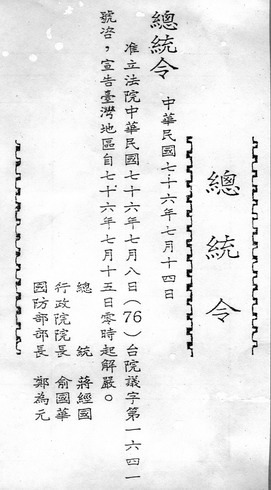It was declared a “watershed moment in its democratization”, but there was no jubilation or dancing in the streets. The Nationalists Kuomintang (KMT) still had a strangle hold on Taiwan’s political system, but this was the beginning of political liberalization and the roots of Taiwanization.
When was Taiwan’s martial law?
Martial law ran from 1949 to 1987, running for 38 years, making it the longest martial law imposed at the time. Today, it is now the second longest as the longest martial law period is the still active martial law imposed on Syria since 1963.
How did the martial law come into effect?
In 1948, the Chinese Nationalist Party (KMT) was poised to lose the Chinese Civil War. In order to prepare the people to fight against Mao’s Chinese Communist Party (CCP), Chiang Kai-Shek, leader of the KMT, imposed martial law to the Republic of China (ROC).
As a reminder, at this time, ROC was the governing body of what current day mainland China.
While this nation-wide martial law did not apply to certain regions of ROC such as Xinjiang, XiKang, QinHai, Tibet and Taiwan, on May 19, 1949, Li Zongren, acting president of ROC, declared martial law in effect in Taiwan.
What was Taiwan like during martial law?
During this period of martial law, there were no political parties, no human rights, and no free speech. Civilians were tried in military court, people’s thinking and reading were controlled, and no freedom of expression. The secret police, known as the Taiwan Garrison Command, arrested anyone critical of the government and were blacklisted.
How did the martial law get removed?

On 1987, July 14, President Chiang Ching-Kuo declared that on July 15, martial law will be lifted. All other laws set in order with the martial law to increase executive branch power were also removed.
What is the aftermath of martial law?
Taiwan in the early 1960s was very militarized, but as time went on, the people started to slowly break down the restrictions of martial law. By the 1980s, after Chiang Kai-shek’s death in April 1975, opposition forces and citizen protest movements were in full swing. An opposition party, the Democratic Progressive Party (DPP) was established in September 1986. Martial law was lifted a year later.
Even after martial law was lifted, some restrictions still applied because the National Security Law was passed, which limited freedom of assembly among other things. However the transition was peaceful compared to the violent martial law transitions of South Korea and the Philippines. “To survive, the party had to identify with this land, this people – so democracy was the only way for Taiwan to survive.”
There are mixed views about this time period, but it was the start of democracy even if
the democracy was “immature, lousy, chaotic”. Taiwan started to have “vital media, a strong opposition, lively party politics, and judicial independence… there [was] no turning back now.” Even the KMT, who adopted Taiwan as their home, started to see themselves as Taiwanese rather than Chinese after 40 years of no contact with the mainland.
Sources:
http://www.wikiwand.com/en/History_of_Taiwan#/Under_martial_law
http://www.wikiwand.com/en/Martial_law_in_Taiwan
http://www.wikiwand.com/en/White_Terror_(Taiwan)
http://www.taiwandc.org/twcom/tc31-int.pdf
http://www.nytimes.com/1987/07/15/world/taiwan-ends-4-decades-of-martial-law.html
http://news.bbc.co.uk/2/hi/asia-pacific/6294902.stm
http://www.roc-taiwan.org/US/SFO/ct.asp?xItem=461607&ctNode=3020&mp=67
http://www.colorado.edu/Economics/mcguire/workingpapers/9aMLawPpr.pdf

